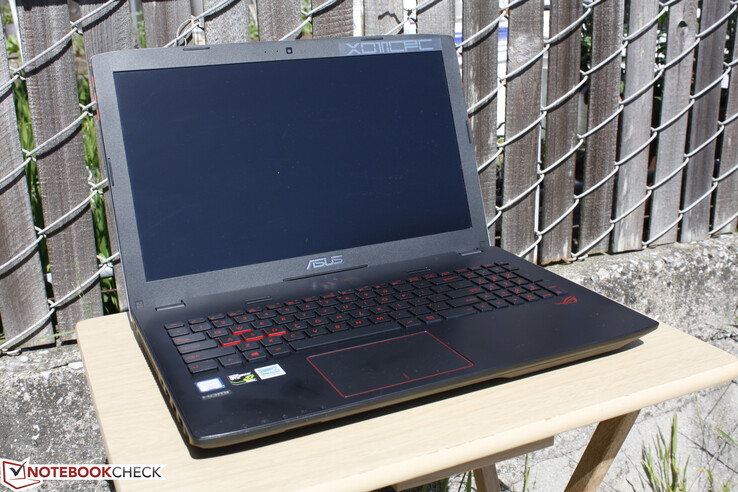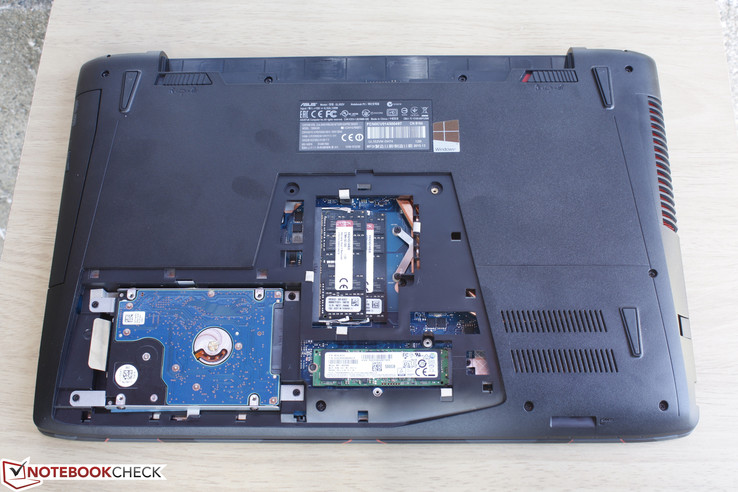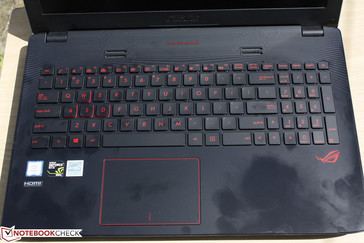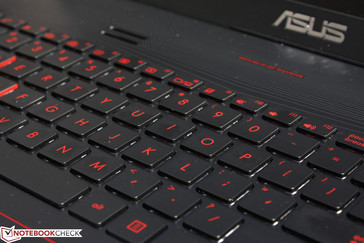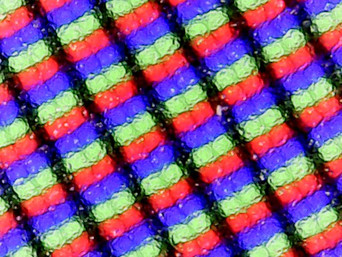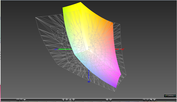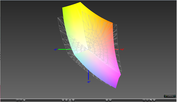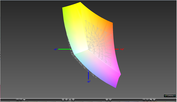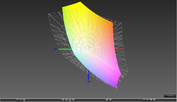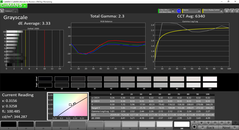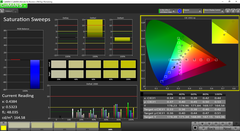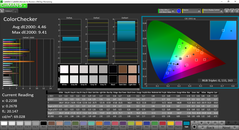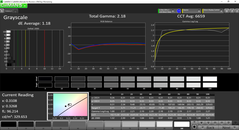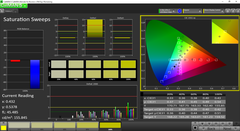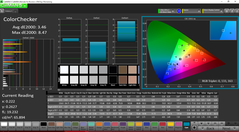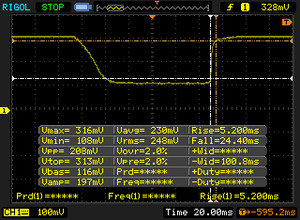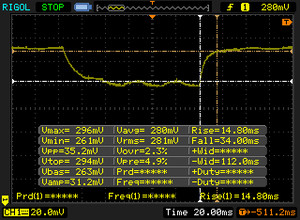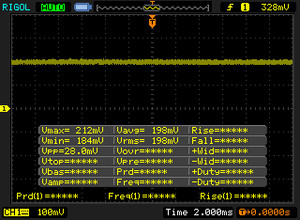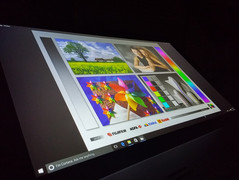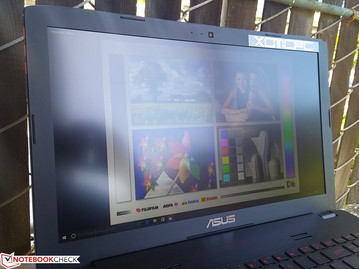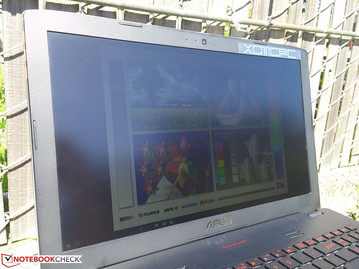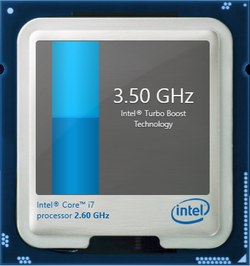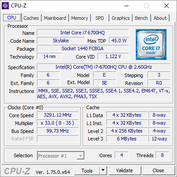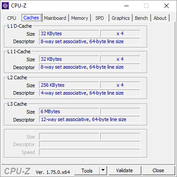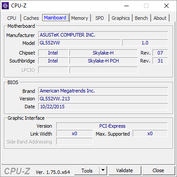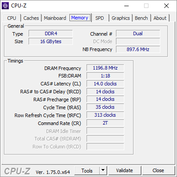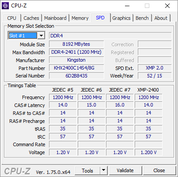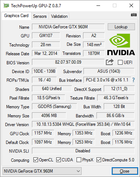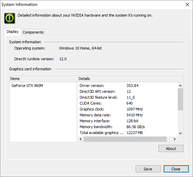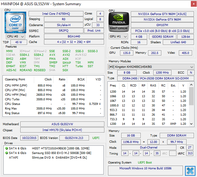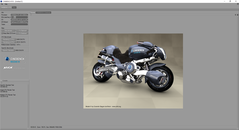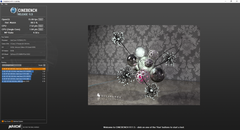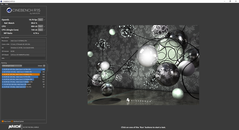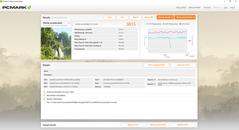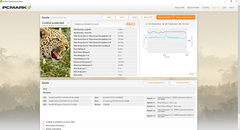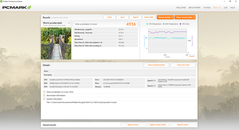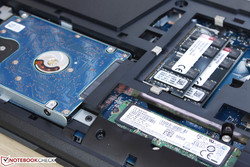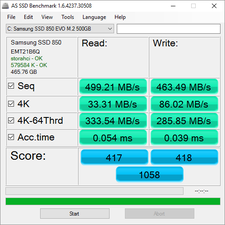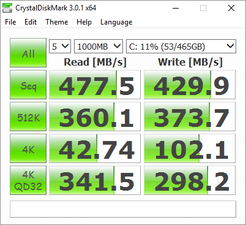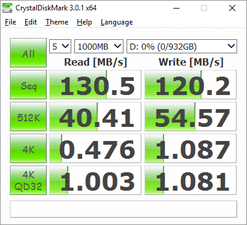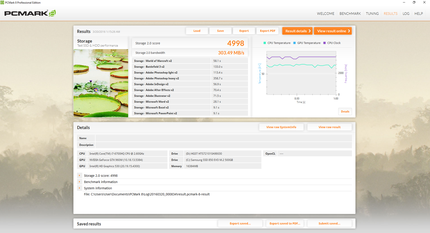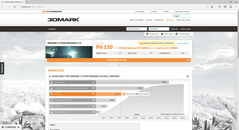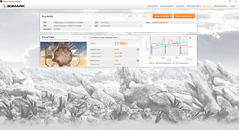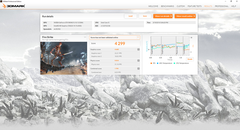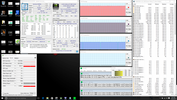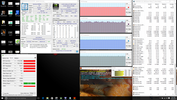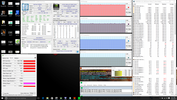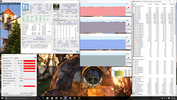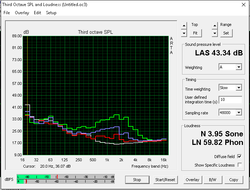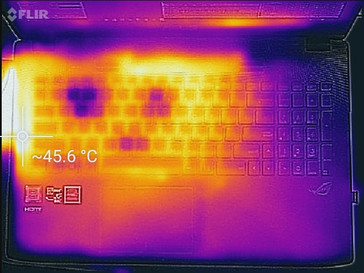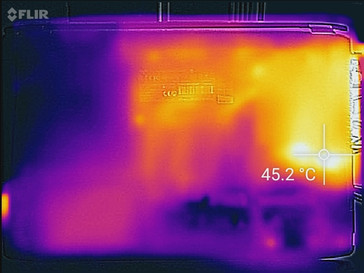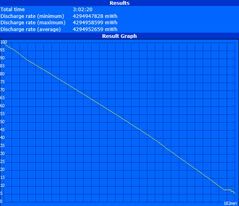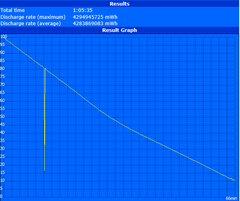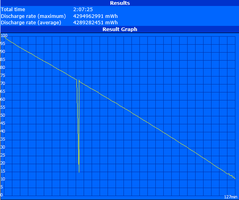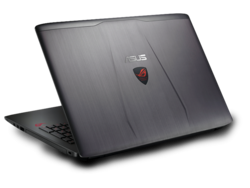Asus GL552VW Xotic PC Edition Notebook Review
Note: We reviewed a configuration from Xotic PC U.S. There can be differences compared to original manufacturer models in respect of the integrated components (memory, RAM, CPU, GPU, etc.) as well as their configurations. Components may have been overclocked. As a result, there can also be differences in terms of performance, emissions, and battery runtimes. The visual appearance of the devices can differ as well.

Unlike the flagship G series or ludicrously powerful GX series, the ROG GL series is the more affordable lineup for gamers on a budget. Models are available in 15.6-inch GL552 or 17.3-inch GL752 form factors and compete directly against mainstream gaming systems like the Acer Aspire Nitro V15 and V17, MSI GE and GP series, and the Lenovo Y50/Y70/Y700 series.
We last checked out the GL552 when it was equipped with the Core i7-4720HQ CPU and GTX 950M GPU. Our latest unit from Xotic PC has been updated to a Skylake i7-6700HQ CPU and GTX 960M GPU with USB Type-C and DDR4 RAM to bring the series up to speed to the latest generation of hardware.
See our previous review on the otherwise identical GL552 for more information on case quality and hardware features. We'll instead focus on the performance of our Xotic PC unit, which is where the system is at its best.
Case
The GL552 carries a major design overhaul compared to the previous GL551, though external features are largely similar between them. This includes the rounded corners and edges and use of smooth plastic with no aluminum surfaces. Unlike our previous test unit, however, the thick base is very rigid and attempting to twist it results in no creaking. Pushing down on the center of the keyboard will cause just minimal warping. The lid is comparatively weaker and more susceptible to twists and depressions with creaking present under moderate force. Its dual hinges are strong nonetheless and teeter very minimally when typing.
Xotic PC customizes the chassis with what appears to be a smooth and airtight vinyl layer over the outer lid. This protects the surface underneath, though it is not made to be easily peeled or removed.
In terms of size and weight, the GL552 is indeed bigger and heavier than many of its competitors. This is especially true when compared to pricier multimedia-centric notebooks like the XPS 15 9550 or ZenBook UX501 that were designed to be carried around. The large GL552 is less ideal for travel and work outside of the home.
Connectivity
Available interfaces are essentially identical to the older GL552JX with just one notable change: The legacy VGA port has been removed in favor of a USB 3.1 Type-C Gen. 1 port. Anyone hoping for integrated Thunderbolt 3 support will need to invest more on a higher-end gaming system where USB 3.1 Type-C Gen. 2 ports are more common. Having just three USB Type-A ports is on the low side for a notebook this size with only two that actually provide USB 3.0 speeds. Most ports are also quite close to the front of the notebook where cables are more likely to take up valuable desk space.
Communication
WLAN is provided by the gaming-centric Killer 1535 network adapter capable of theoretical transfer rates of up to 867 Mbps. We experienced no connectivity issues or unintended drops during our time with the test unit.
Accessories
Included extras outside of the usual Warranty Card and User Guide are a cable tie and pouch that also doubles as a wipe. Asus offers generic and branded extras for its ROG series.
Maintenance
Only the two storage bays and two SODIMM slots are easily accessible on the GL552 via the removable hatch. This is practically an Asus tradition as accessibility to core motherboard components is always quite limited for ROG notebooks. The optical bay is not easily removable (unlike on most MSI models) and additional disassembly is required to replace the WLAN card or clean the system fan.
Warranty
The standard one-year OEM coverage from Asus applies. Owners can also receive one year of accidental damage protection by registering the notebook with the manufacturer. Extended warranty options are available up to three years.
Input Devices
Keyboard
The chiclet keys provide 1.8 mm of travel and multiple levels of Red backlight lighting. Auditory feedback is generally quiet while tactile feedback is firm with a clear pressure point. The keys themselves are matte and slightly rough in contrast to the smooth palm rests to reduce slipping and increase accuracy.
The system offers no dedicated macro or auxiliary keys as found on the current flagship G752 series.
Touchpad
The touchpad surface (10.5 x 7.3) offers a smooth and even glide with responsive multi-touch controls. The entirety of the surface can be used for cursor control including the bottom portion for mouse clicks. We experienced no latency or control issues with the touchpad.
Mouse clicks with the clickpad feel shallow in travel with a firm and loud click when pressed. Left and right clicks are even and become easier to press on the lower areas of the clickpad. The force required to input a click is somewhat light, so users may want to be careful to not push too firmly when using the touchpad for cursor movements.
Display
The 1080p matte display is crisp with no noise or grains that tend to occur more frequently on matte panels. Its average brightness of just over 300 nits is similar to pricier gaming notebooks and is more than sufficient for indoor use. The notebook exhibits excellent contrast as well. A quick search for its LG Philips LP156WF6-SPB5 panel name shows that the same high quality panel is also used on the Asus N552VX.
There is moderate backlight bleeding near the top corners of the screen on our test unit. The clouding here is significant enough that it is noticeable when watching movies, booting up the notebook, or playing games that include dimly lit scenes.
| |||||||||||||||||||||||||
Brightness Distribution: 87 %
Center on Battery: 333 cd/m²
Contrast: 835:1 (Black: 0.399 cd/m²)
ΔE ColorChecker Calman: 4.46 | ∀{0.5-29.43 Ø4.78}
ΔE Greyscale Calman: 3.33 | ∀{0.09-98 Ø5}
81.2% sRGB (Argyll 1.6.3 3D)
53.3% AdobeRGB 1998 (Argyll 1.6.3 3D)
59.6% AdobeRGB 1998 (Argyll 3D)
81.5% sRGB (Argyll 3D)
63.2% Display P3 (Argyll 3D)
Gamma: 2.3
CCT: 6340 K
| Asus GL552VW-DH74 15.6", 1920x1080 | Asus N552VX-FY103T 15.6", 1920x1080 | Acer Aspire V3-575G-5093 15.6", 1920x1080 | Lenovo Ideapad 500-15ACZ 15.6", 1920x1080 | Asus ZenBook Pro UX501VW-DS71T 15.6", 3840x2160 | |
|---|---|---|---|---|---|
| Display | 7% | -32% | 7% | ||
| Display P3 Coverage (%) | 63.2 | 67.9 7% | 39.82 -37% | 64.3 2% | |
| sRGB Coverage (%) | 81.5 | 87.7 8% | 59.7 -27% | 89.9 10% | |
| AdobeRGB 1998 Coverage (%) | 59.6 | 64 7% | 41.16 -31% | 65.4 10% | |
| Response Times | 13% | 16% | 16% | 10% | |
| Response Time Grey 50% / Grey 80% * (ms) | 48.8 ? | 42 ? 14% | 44 ? 10% | 43 ? 12% | 43.2 ? 11% |
| Response Time Black / White * (ms) | 29.6 ? | 26 ? 12% | 23 ? 22% | 24 ? 19% | 27.2 ? 8% |
| PWM Frequency (Hz) | 1042 ? | ||||
| Screen | -1% | -50% | -69% | -19% | |
| Brightness middle (cd/m²) | 333 | 336 1% | 251 -25% | 238 -29% | 252.9 -24% |
| Brightness (cd/m²) | 309 | 304 -2% | 239 -23% | 221 -28% | 250 -19% |
| Brightness Distribution (%) | 87 | 85 -2% | 87 0% | 84 -3% | 89 2% |
| Black Level * (cd/m²) | 0.399 | 0.34 15% | 0.42 -5% | 0.49 -23% | 0.5 -25% |
| Contrast (:1) | 835 | 988 18% | 598 -28% | 486 -42% | 506 -39% |
| Colorchecker dE 2000 * | 4.46 | 5.26 -18% | 9.68 -117% | 11.19 -151% | 5.22 -17% |
| Colorchecker dE 2000 max. * | 9.41 | 10.49 -11% | 14.83 -58% | 19.6 -108% | 8.33 11% |
| Greyscale dE 2000 * | 3.33 | 4.26 -28% | 11.13 -234% | 11.53 -246% | 6.74 -102% |
| Gamma | 2.3 96% | 2.35 94% | 2.46 89% | 2.41 91% | 2.45 90% |
| CCT | 6340 103% | 6758 96% | 12149 54% | 13057 50% | 6026 108% |
| Color Space (Percent of AdobeRGB 1998) (%) | 53.3 | 57 7% | 74 39% | 38 -29% | 58.4 10% |
| Color Space (Percent of sRGB) (%) | 81.2 | 88 8% | 60 -26% | 89.7 10% | |
| Total Average (Program / Settings) | 6% /
2% | -17% /
-38% | -28% /
-50% | -1% /
-10% |
* ... smaller is better
Color coverage is measured to be 53 percent and 81 percent of AdobeRGB and sRGB standards, respectively. This is standard for high-end IPS panels whereas cheaper panels often cover less than 40 percent and 65 percent of AdobeRGB and sRGB, respectively, such as the panel used for the Lenovo Ideapad 500 15ACZ. It's worth noting that certain configurations of the GL552 come equipped with different panels to cover a wider color spectrum.
Further display measurements with an X-Rite spectrophotometer reveal accurate grayscale and colors without any calibration efforts. A quick calibration will improve these properties even further, especially in terms of RGB balance and grayscale by slightly increasing the color temperature. Colors still become increasingly inaccurate at higher saturation levels due to imperfect sRGB coverage.
Display Response Times
| ↔ Response Time Black to White | ||
|---|---|---|
| 29.6 ms ... rise ↗ and fall ↘ combined | ↗ 5.2 ms rise | |
| ↘ 24.4 ms fall | ||
| The screen shows relatively slow response rates in our tests and may be too slow for gamers. In comparison, all tested devices range from 0.1 (minimum) to 240 (maximum) ms. » 78 % of all devices are better. This means that the measured response time is worse than the average of all tested devices (20.2 ms). | ||
| ↔ Response Time 50% Grey to 80% Grey | ||
| 48.8 ms ... rise ↗ and fall ↘ combined | ↗ 14.8 ms rise | |
| ↘ 34 ms fall | ||
| The screen shows slow response rates in our tests and will be unsatisfactory for gamers. In comparison, all tested devices range from 0.165 (minimum) to 636 (maximum) ms. » 84 % of all devices are better. This means that the measured response time is worse than the average of all tested devices (31.6 ms). | ||
Screen Flickering / PWM (Pulse-Width Modulation)
| Screen flickering / PWM not detected | |||
In comparison: 53 % of all tested devices do not use PWM to dim the display. If PWM was detected, an average of 8108 (minimum: 5 - maximum: 343500) Hz was measured. | |||
Outdoor visibility is average under shade due to the relatively bright backlight, matte panel to avoid reflections, and wide IPS angles. Direct sunlight will wash out onscreen content and can make prolonged use uncomfortable to the eyes. Viewing angles are very stable from all sides while the hinges allow for an angle of about 150 degrees.
Performance
Our test unit is equipped with a quad-core Core i7-6700HQ CPU and GTX 960M GPU with 4 GB GDDR5 VRAM. These are common specifications for higher-end mainstream gaming notebooks whereas flagship enthusiast models can often carry i7-6820HK and GTX 980M options. The Skylake core can run slower than 1000 MHz when idling on the Power Saver mode and as fast as 3.5 GHz for single-threaded processes when on High Performance. Similarly, the GPU will idle at just 135/202 MHz core/memory and can run as fast as 1097/1352 MHz core/memory plus Boost. Optimus is included for additional power-saving features with the integrated HD Graphics 530.
Two DDR4 SODIMM Kingston modules provide a total of 16 GB of RAM.
Processor
Raw CPU performance is nearly identical to the Broadwell i7-5700HQ due to the two processors having the same specifications aside from the slightly higher base clock rate of the i7-5700HQ (2.7 GHz vs. 2.6 GHz). The multi-core performance advantage of the Broadwell core is negligible in most cases, but it adds up over longer workloads such as on the wPrime benchmark where the i7-5700HQ finishes about 10 percent faster.
See our dedicated CPU page on the Core i7-6700HQ for more technical information and benchmarks.
| Cinebench R15 | |
| CPU Single 64Bit (sort by value) | |
| Asus GL552VW-DH74 | |
| Eurocom Sky DLX7 | |
| Asus GX700 | |
| MSI GE62 2QC-468XPL | |
| Lenovo IdeaPad Y50 | |
| CPU Multi 64Bit (sort by value) | |
| Asus GL552VW-DH74 | |
| Eurocom Sky DLX7 | |
| Asus GX700 | |
| MSI GE62 2QC-468XPL | |
| Lenovo IdeaPad Y50 | |
| Cinebench R11.5 | |
| CPU Single 64Bit (sort by value) | |
| Asus GL552VW-DH74 | |
| Eurocom Sky DLX7 | |
| Asus GX700 | |
| MSI GE62 2QC-468XPL | |
| Lenovo IdeaPad Y50 | |
| CPU Multi 64Bit (sort by value) | |
| Asus GL552VW-DH74 | |
| Eurocom Sky DLX7 | |
| Asus GX700 | |
| MSI GE62 2QC-468XPL | |
| Lenovo IdeaPad Y50 | |
| Cinebench R10 | |
| Rendering Single 32Bit (sort by value) | |
| Asus GL552VW-DH74 | |
| Eurocom Sky DLX7 | |
| Asus GX700 | |
| MSI GE62 2QC-468XPL | |
| Lenovo IdeaPad Y50 | |
| Rendering Multiple CPUs 32Bit (sort by value) | |
| Asus GL552VW-DH74 | |
| Eurocom Sky DLX7 | |
| Asus GX700 | |
| MSI GE62 2QC-468XPL | |
| Lenovo IdeaPad Y50 | |
| wPrime 2.10 - 1024m (sort by value) | |
| Asus GL552VW-DH74 | |
| Eurocom Sky DLX7 | |
| MSI GE62 2QC-468XPL | |
| Lenovo IdeaPad Y50 | |
| Super Pi Mod 1.5 XS 32M - 32M (sort by value) | |
| Asus GL552VW-DH74 | |
| Eurocom Sky DLX7 | |
| MSI GE62 2QC-468XPL | |
| Lenovo IdeaPad Y50 | |
* ... smaller is better
System Performance
Results from PCMark 8 are better than expected as our test unit is able to edge out the similarly equipped Asus G501VW and Zenbook UX501. The small advantage may be attributed to the system's Turbo Boost performance when under stress and overclocked GPU memory.
| PCMark 8 | |
| Home Score Accelerated v2 (sort by value) | |
| Asus GL552VW-DH74 | |
| Asus G501VW-FY081T | |
| Asus N552VX-FY103T | |
| Asus ZenBook Pro UX501VW-DS71T | |
| Lenovo Ideapad 500-15ACZ | |
| Work Score Accelerated v2 (sort by value) | |
| Asus GL552VW-DH74 | |
| Asus G501VW-FY081T | |
| Asus N552VX-FY103T | |
| Asus ZenBook Pro UX501VW-DS71T | |
| Lenovo Ideapad 500-15ACZ | |
| Creative Score Accelerated v2 (sort by value) | |
| Asus GL552VW-DH74 | |
| Asus G501VW-FY081T | |
| Asus ZenBook Pro UX501VW-DS71T | |
| Lenovo Ideapad 500-15ACZ | |
| PCMark 8 Home Score Accelerated v2 | 3855 points | |
| PCMark 8 Creative Score Accelerated v2 | 4843 points | |
| PCMark 8 Work Score Accelerated v2 | 4916 points | |
Help | ||
Storage Devices
Two storage options are available via a 2.5-inch SATA III bay and a M.2 2280 slot. Transfer rates are limited to 6 Gb/s on both accounts, so systems with NVMe support like the Zenbook UX501 or XPS 15 9550 will run laps around the GL552 in terms of storage performance. RAID capabilities are not officially supported on the system.
The primary 500 GB Samsung SSD 850 EVO drive still performs very well for its class as it handily outperforms other SATA III SSDs as found on the Ideapad Y700 and MSI GE62. Sequential read speeds are more or less capped at 500 MB/s due to the limits of the controller. Meanwhile, the secondary 9.5 mm HGST HDD returns an average transfer rate of just under 102 MB/s according to HD Tune, which is typical of a 7200 RPM drive.
| Asus GL552VW-DH74 GeForce GTX 960M, 6700HQ, Samsung SSD 850 EVO M.2 500GB | Asus GL552JX-CN154H GeForce GTX 950M, 4720HQ, Micron M600 MTFDDAV128MBF | Lenovo Ideapad Y700 15ISK 80NW GeForce GTX 960M, 6700HQ, Samsung MZNLN128HCGR-000L2 | MSI GE62-6QD16H11 GeForce GTX 960M, 6700HQ, Samsung SSD 850 EVO M.2 250 GB | Asus ZenBook Pro UX501VW-DS71T GeForce GTX 960M, 6700HQ, Samsung SM951 MZVPV512HDGL m.2 PCI-e | Dell XPS 15 9550 i7 FHD GeForce GTX 960M, 6700HQ, Samsung PM951 NVMe 512 GB | |
|---|---|---|---|---|---|---|
| AS SSD | -10% | -23% | -29% | 116% | 91% | |
| Copy Game MB/s (MB/s) | 372.8 | 302 -19% | 353.9 -5% | 684 83% | 805 116% | |
| Copy Program MB/s (MB/s) | 260.1 | 159.1 -39% | 197.1 -24% | 452 74% | 325.3 25% | |
| Copy ISO MB/s (MB/s) | 401.6 | 295.6 -26% | 391.6 -2% | 1206 200% | 1127 181% | |
| Score Total (Points) | 1058 | 1018 -4% | 883 -17% | 870 -18% | 2588 145% | 2410 128% |
| Score Write (Points) | 418 | 386 -8% | 251 -40% | 268 -36% | 619 48% | 675 61% |
| Score Read (Points) | 417 | 416 0% | 421 1% | 397 -5% | 1312 215% | 1180 183% |
| Access Time Write * (ms) | 0.039 | 0.049 -26% | 0.039 -0% | 0.041 -5% | 0.034 13% | 0.035 10% |
| Access Time Read * (ms) | 0.054 | 0.079 -46% | 0.094 -74% | 0.168 -211% | 0.037 31% | 0.038 30% |
| 4K-64 Write (MB/s) | 285.9 | 257.3 -10% | 142.3 -50% | 153.3 -46% | 361.7 27% | 513 79% |
| 4K-64 Read (MB/s) | 333.5 | 334.7 0% | 337.5 1% | 327.6 -2% | 1075 222% | 990 197% |
| 4K Write (MB/s) | 86 | 91.1 6% | 94 9% | 72.9 -15% | 107.8 25% | 105.4 23% |
| 4K Read (MB/s) | 33.31 | 29.5 -11% | 34.29 3% | 21.05 -37% | 43.59 31% | 31.86 -4% |
| Seq Write (MB/s) | 463.5 | 378.7 -18% | 151 -67% | 449.1 -3% | 1498 223% | 570 23% |
| Seq Read (MB/s) | 499.2 | 518 4% | 492 -1% | 500 0% | 1944 289% | 1579 216% |
* ... smaller is better
GPU Performance
3DMark benchmarks show our system to be just a few percentage points ahead of the similarly equipped Acer Aspire V15 Nitro in all cases. This can be attributed to the overclocked memory at 5410 MHz compared to the standard 5010 MHz clock rate on the base GTX 960M. Nonetheless, the gap between our unit and other systems with the GTX 970M is very wide.
| 3DMark 11 Performance | 6110 points | |
| 3DMark Ice Storm Standard Score | 84816 points | |
| 3DMark Cloud Gate Standard Score | 17983 points | |
| 3DMark Fire Strike Score | 4299 points | |
| 3DMark Fire Strike Extreme Score | 2156 points | |
Help | ||
Gaming Performance
The GTX 960M is a common GPU for dedicated gaming machines. Its performance in our Xotic PC machine is slightly above the average 960M GPU due to the aforementioned memory overclock. The GTX 970M still holds a healthy lead in all cases.
See our dedicated GPU page on the GTX 960M for more benchmarks and comparisons.
| Rise of the Tomb Raider | |
| 1920x1080 High Preset AA:FX AF:4x (sort by value) | |
| Asus GL552VW-DH74 | |
| DogHouse Systems Mobius SS | |
| Gigabyte P55W v5 | |
| Dell XPS 15 9550 i7 FHD | |
| Asus N752VX-GC131T | |
| 1920x1080 Very High Preset AA:FX AF:16x (sort by value) | |
| Asus GL552VW-DH74 | |
| DogHouse Systems Mobius SS | |
| Gigabyte P55W v5 | |
| Dell XPS 15 9550 i7 FHD | |
| Asus N752VX-GC131T | |
| BioShock Infinite | |
| 1366x768 High Preset (sort by value) | |
| Asus GL552VW-DH74 | |
| DogHouse Systems Mobius SS | |
| Gigabyte P55W v5 | |
| Dell XPS 15 9550 i7 FHD | |
| Asus N752VX-GC131T | |
| 1920x1080 Ultra Preset, DX11 (DDOF) (sort by value) | |
| Asus GL552VW-DH74 | |
| DogHouse Systems Mobius SS | |
| Gigabyte P55W v5 | |
| Dell XPS 15 9550 i7 FHD | |
| Asus N752VX-GC131T | |
| Metro: Last Light | |
| 1366x768 High (DX11) AF:16x (sort by value) | |
| Asus GL552VW-DH74 | |
| DogHouse Systems Mobius SS | |
| Dell XPS 15 9550 i7 FHD | |
| 1920x1080 Very High (DX11) AF:16x (sort by value) | |
| Asus GL552VW-DH74 | |
| DogHouse Systems Mobius SS | |
| Dell XPS 15 9550 i7 FHD | |
| Thief | |
| 1366x768 High Preset AA:FXAA & Low SS AF:4x (sort by value) | |
| Asus GL552VW-DH74 | |
| DogHouse Systems Mobius SS | |
| Dell XPS 15 9550 i7 FHD | |
| Asus N752VX-GC131T | |
| 1920x1080 Very High Preset AA:FXAA & High SS AF:8x (sort by value) | |
| Asus GL552VW-DH74 | |
| DogHouse Systems Mobius SS | |
| Dell XPS 15 9550 i7 FHD | |
| Asus N752VX-GC131T | |
| Batman: Arkham Knight | |
| 1920x1080 High / On (Interactive Smoke & Paper Debris Off) AA:SM AF:8x (sort by value) | |
| Asus GL552VW-DH74 | |
| DogHouse Systems Mobius SS | |
| Gigabyte P55W v5 | |
| Dell XPS 15 9550 i7 FHD | |
| Asus N752VX-GC131T | |
| 1920x1080 High / On AA:SM AF:16x (sort by value) | |
| Asus GL552VW-DH74 | |
| DogHouse Systems Mobius SS | |
| Gigabyte P55W v5 | |
| Dell XPS 15 9550 i7 FHD | |
| Asus N752VX-GC131T | |
| low | med. | high | ultra | |
|---|---|---|---|---|
| BioShock Infinite (2013) | 138.3 | 126.9 | 49.5 | |
| Metro: Last Light (2013) | 109.1 | 62.6 | 34 | |
| Thief (2014) | 69.4 | 58.6 | 30 | |
| Batman: Arkham Knight (2015) | 64 | 36 | 25 | |
| Rise of the Tomb Raider (2016) | 55.3 | 30.3 | 25.2 |
Stress Test
The system runs very well when under extreme stress. Clock rate is at its steady Turbo Boost maximum of 3.1 GHz when running Prime95 with an average CPU temperature of just under 80 C. Running both Prime95 and FurMark simultaneously will limit CPU Turbo Boost potential while the GPU throttles slightly from its base clock of 1097 MHz to 1027 MHz. Maximum Turbo Boost is utilized only for a very limited time until core CPU temperature reaches 96 C. At this point, clock rates drop to 2.8 GHz to maintain a lower core temperature of 86 C.
Performance under Unigine Heaven is higher with constant CPU Turbo Boost and a steady GPU clock rate of 1262 MHz. Core temperatures are also typical at the low to mid 70 C range considering the GPU overclock. Users won't need to worry about throttling issues when gaming on the GL552.
Running on battery power will severely limit CPU and GPU power. A 3DMark 11 run on battery power resulted in a GPU and CPU of 1510 and 4294 points, respectively, compared to 5779 points and 9007 points when on mains.
| CPU Clock (GHz) | GPU Clock (MHz) | Average CPU Temperature (C) | Average GPU Temperature (C) | |
Prime95 Stress |
3.1 | -- | ~78 | -- |
FurMark Stress |
-- | 1176 | -- | ~76 |
Prime95 + FurMark Stress |
2.8 | 1027 | ~86 | ~79 |
Unigine Heaven Stress |
3.2+ | 1262 | ~71 | ~76 |
Emissions
System Noise
Fan noise is always audible at around 33 dB(A) due in part to the reseller overclocking efforts. The good news, however, is that fan noise will not get that much louder when gaming since it is already quite active when the system is idling on desktop. We were able to record a steady fan noise of about 36.6 dB(A) when running Unigine Heaven and 44 dB(A) when running both Prime95+FurMark.
Our Xotic PC GL552 is not significantly louder or softer on average than many of its competitors. Fan noise when gaming is even slightly lower than the thinner ZenBook UX501. Its maximum load of 44 dB(A) will be very unlikely under normal circumstances unless if the system is running specific benchmarks or is overclocked further.
| Asus GL552VW-DH74 GeForce GTX 960M, 6700HQ, Samsung SSD 850 EVO M.2 500GB | Asus GL552JX-CN154H GeForce GTX 950M, 4720HQ, Micron M600 MTFDDAV128MBF | Asus N552VX-FY103T GeForce GTX 950M, 6700HQ, Toshiba MQ02ABD100H | Acer Aspire V3-575G-5093 GeForce 940M, 6200U, Toshiba MQ01ABD100 | Lenovo Ideapad 500-15ACZ Radeon R6 M340DX, A10-8700P, Seagate Momentus SpinPoint M8 ST1000LM024 | Asus ZenBook Pro UX501VW-DS71T GeForce GTX 960M, 6700HQ, Samsung SM951 MZVPV512HDGL m.2 PCI-e | |
|---|---|---|---|---|---|---|
| Noise | 5% | -1% | -4% | 0% | 4% | |
| off / environment * (dB) | 29.7 | 31.3 -5% | 31.3 -5% | 31.3 -5% | ||
| Idle Minimum * (dB) | 33.2 | 30 10% | 33.1 -0% | 33.5 -1% | 33.1 -0% | 28.9 13% |
| Idle Average * (dB) | 33.2 | 30 10% | 33.2 -0% | 34.8 -5% | 33.3 -0% | 28.9 13% |
| Idle Maximum * (dB) | 33.3 | 31.3 6% | 33.2 -0% | 34.8 -5% | 33.5 -1% | 30.2 9% |
| Load Average * (dB) | 36.6 | 36.9 -1% | 37.7 -3% | 41.4 -13% | 38.9 -6% | 41.8 -14% |
| Load Maximum * (dB) | 44 | 44.7 -2% | 43.4 1% | 42 5% | 38.9 12% | 43.9 -0% |
* ... smaller is better
Noise level
| Idle |
| 33.2 / 33.2 / 33.3 dB(A) |
| DVD |
| 37 / dB(A) |
| Load |
| 36.6 / 44 dB(A) |
 | ||
30 dB silent 40 dB(A) audible 50 dB(A) loud |
||
min: | ||
Temperature
Surface temperatures are cool when idling with the exception of the front areas of the notebook where the storage drives are located. These spots can be over 33 C compared to 25 C on surfaces closer to the optical drive.
When under maximum load, we were able to record warm spots of over 45 C near the edges of the notebook closest to the ventilation grilles. These hot spots are not directly over the CPU or GPU because of the air gap that exists between the processors and the chassis. Unfortunately, this also means that the left side of the side of the keyboard will grow much warmer than the right when under high loads like gaming.
Competing models like the MSI GE62 can grow much warmer with an average approaching 50 C while the Ideapad Y700 15ISK is generally cooler with most of the heat production concentrated towards the rear of the notebook and away from the WASD keys.
(-) The maximum temperature on the upper side is 45.6 °C / 114 F, compared to the average of 40.4 °C / 105 F, ranging from 21.2 to 68.8 °C for the class Gaming.
(-) The bottom heats up to a maximum of 45.2 °C / 113 F, compared to the average of 43.3 °C / 110 F
(+) In idle usage, the average temperature for the upper side is 28.4 °C / 83 F, compared to the device average of 33.9 °C / 93 F.
(+) The palmrests and touchpad are reaching skin temperature as a maximum (33.2 °C / 91.8 F) and are therefore not hot.
(-) The average temperature of the palmrest area of similar devices was 28.9 °C / 84 F (-4.3 °C / -7.8 F).
Speakers
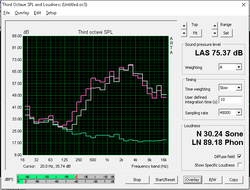
Sound quality from the stereo speakers located directly above the keyboard is average at best. There is a clear lack of bass despite what the size of the notebook may otherwise suggest and the maximum volume is lower than on other gaming notebooks. Playback at higher volume settings will not introduce static or rattling, but earphones are still recommended for a much better experience.
Energy Management
Power Consumption
Power demand is high even when idling on desktop. Consequently, runtimes are quite short as shown in our battery life test results in the next section. We were able to measure a peak draw of about 114 W while the adapter itself is rated for a maximum output of 139 W.
| Asus GL552VW-DH74 GeForce GTX 960M, 6700HQ, Samsung SSD 850 EVO M.2 500GB | Asus GL552JX-CN154H GeForce GTX 950M, 4720HQ, Micron M600 MTFDDAV128MBF | Asus N552VX-FY103T GeForce GTX 950M, 6700HQ, Toshiba MQ02ABD100H | Acer Aspire V3-575G-5093 GeForce 940M, 6200U, Toshiba MQ01ABD100 | Lenovo Ideapad 500-15ACZ Radeon R6 M340DX, A10-8700P, Seagate Momentus SpinPoint M8 ST1000LM024 | Asus Zenbook Pro UX501JW-FI218H GeForce GTX 960M, 4720HQ, SanDisk SD7SN3Q128G1002 | |
|---|---|---|---|---|---|---|
| Power Consumption | 35% | 34% | 56% | 54% | 13% | |
| Idle Minimum * (Watt) | 15.9 | 6.2 61% | 7 56% | 6.2 61% | 6.8 57% | 15.6 2% |
| Idle Average * (Watt) | 20.3 | 10.3 49% | 10.9 46% | 9.5 53% | 10.5 48% | 20.5 -1% |
| Idle Maximum * (Watt) | 27.9 | 12.2 56% | 12.9 54% | 11 61% | 11 61% | 21.2 24% |
| Load Average * (Watt) | 79.4 | 77 3% | 72 9% | 36 55% | 41.6 48% | 75.8 5% |
| Load Maximum * (Watt) | 114.2 | 105 8% | 109 5% | 58 49% | 51 55% | 72.9 36% |
* ... smaller is better
| Off / Standby | |
| Idle | |
| Load |
|
Key:
min: | |
Battery Life
Runtimes are poor with our test unit at just over 2 hours under WLAN conditions (150 nit brightness, Balanced profile, integrated graphics active) compared to over double the battery life on the Asus N552 or Zenbook UX501 under similar conditions. This is a common occurrence on our Xotic PC test units due to the performance tinkering before shipment. Luckily, the internal 48 Wh battery is easily removable and replaceable from the rear, which is more than what we can say for most other gaming notebooks these days.
Charging will take approximately 2.5 hours from near zero to full capacity. The adapter is relatively small in size at about 16 x 7.5 x 3.5 cm.
| Asus GL552VW-DH74 48 Wh | Asus GL552JX-CN154H 48 Wh | Asus N552VX-FY103T 44 Wh | Acer Aspire V3-575G-5093 37 Wh | Lenovo Ideapad 500-15ACZ 32 Wh | Asus ZenBook Pro UX501VW-DS71T 96 Wh | |
|---|---|---|---|---|---|---|
| Battery runtime | 51% | 71% | 100% | 41% | 188% | |
| Reader / Idle (h) | 3 | 3.7 23% | 6 100% | 7.1 137% | 6.1 103% | 11.5 283% |
| WiFi v1.3 (h) | 2.1 | 3.7 76% | 4.5 114% | 4 90% | 3.1 48% | 6.3 200% |
| Load (h) | 1.1 | 1.7 55% | 1.1 0% | 1.9 73% | 0.8 -27% | 2 82% |
| WiFi (h) | 4 |
Pros
Cons
Verdict
Our analyses and conclusions are based on the conditions of the notebook out-of-the-box. Since Xotic PC units come overclocked and ready to go, our measurements related to temperatures, fan noise, performance, and battery life may be different from a stock GL552VW. Indeed, the raw GPU performance of our Xotic PC GL552VW is consistently ahead of other systems with a stock GTX 960M at the very tangible costs of louder fan noise, higher power draw, and shorter battery life. These drawbacks are less likely to bother users looking for a primary gaming notebook that's seldom used outside of mains.
Reasons to skip the Asus GL552 and opt in for the MSI GE62 include the smaller size and lighter weight of the latter without sacrificing case quality. The MSI notebook is also easier to troubleshoot and with sharper looks, though with a weaker cooling system and with warmer components under stress.
Weight and size are the biggest downsides of the GL552VW. If users can live with a mainly indoor gaming notebook, then the Asus offers an excellent 1080p IPS display, good overclocking headroom, and a rigid no-frills chassis. The cut corners and features are very apparent compared to costlier models like the Asus G752 or MSI GT72S.
Asus GL552VW-DH74
- 04/18/2016 v5.1 (old)
Allen Ngo




